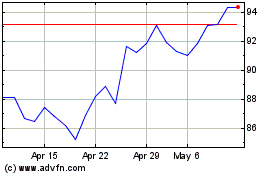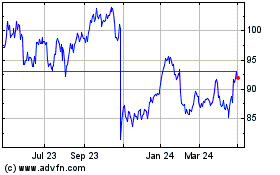European Commission approves second indication of Sarclisa®
(isatuximab) for relapsed multiple myeloma
European
Commission approves second
indication of Sarclisa®
(isatuximab) for relapsed
multiple myeloma
- Approval based on Phase 3 IKEMA study demonstrating Sarclisa
added to standard of care carfilzomib and dexamethasone reduced
risk of disease progression or death by 47% in patients who had
relapsed after one to three prior therapies
- Sarclisa combination therapy was associated with undetectable
levels of multiple myeloma (MM) in nearly 30% of patients with
relapsed MM
- Second EU approval in less than 12 months for Sarclisa in
combination with a standard of care regimen for the treatment of
relapsed or refractory MM
PARIS –
April 19, 2021 –
Today, the European Commission (EC) approved Sarclisa® (isatuximab)
in combination with carfilzomib and dexamethasone (Kd) for the
treatment of adult patients with relapsed multiple myeloma who have
received at least one prior therapy. This marks the second EC
approval of Sarclisa in combination with a standard of care regimen
in less than 12 months.
“As there is no cure for multiple myeloma and
patients often experience disease relapse, we must persist in our
pursuit for additional treatment options. Nearly 30% of patients
treated with the Sarclisa regimen had a profound response with
undetectable levels of multiple myeloma,” said Philippe Moreau,
M.D., Department of Hematology, University Hospital of Nantes,
France. “This new therapeutic regimen has the potential to become a
standard of care for patients with relapsed multiple myeloma, who
now have another treatment option earlier in the progression of
their disease.”
This EC approval closely follows the U.S. Food
and Drug Administration (FDA) approval of Sarclisa for a similar
indication in March 2021. In June 2020, Sanofi announced Sarclisa
received EC approval in combination with another standard of care
regimen, pomalidomide and dexamethasone (pom-dex), for the
treatment of adult patients with relapsed and refractory MM who
have received at least two prior therapies including lenalidomide
and a proteasome inhibitor and have demonstrated disease
progression on the last therapy.
“The EC approval of Sarclisa in combination with
carfilzomib and dexamethasone means patients living with multiple
myeloma in Europe can now receive Sarclisa in combination with two
standard of care treatment regimens,” said Peter C. Adamson, Global
Development Head, Oncology and Pediatric Innovation at Sanofi. “The
carfilzomib and dexamethasone combination represents an important
standard of care in Europe. The Phase 3 IKEMA trial’s finding that
the addition of Sarclisa to this regimen reduced the risk of
progression or death by nearly half formed the basis for this
important EC approval.”
Sarclisa Efficacy and Safety Profile in
Difficult-to-Treat Patients
This approval is based on data from the Phase 3
IKEMA study, a randomized, multi-center, open label clinical trial
that enrolled 302 patients with relapsed MM across 69 centers
spanning 16 countries. The primary endpoint of IKEMA was
progression free survival (PFS). While median PFS, defined as time
to disease progression or death, for Kd was 19.15 months, the
median PFS for patients receiving Sarclisa added to carfilzomib and
dexamethasone (Sarclisa combination therapy; n=179) had not been
reached at the time of the pre-planned interim analysis. Sarclisa
combination therapy reduced the risk of disease progression or
death by 47% (hazard ratio 0.531, 99% CI 0.318-0.889, p=0.0007)
versus standard of care Kd alone in patients with MM.
Secondary endpoints of the IKEMA trial assessed
the depth of response for Sarclisa combination therapy compared to
Kd, including overall response rate (ORR), complete response (CR),
very good partial response (VGPR) and minimal residual disease
(MRD)-negative response. The ORR remained similar for each arm at
86.6% for the Sarclisa combination therapy versus 82.9% for Kd but
was not statistically significant. The rate of CR was 39.7% in the
Sarclisa combination therapy arm and 27.6% in the Kd arm. The rate
of VGPR or better was 72.6% for patients receiving Sarclisa
combination therapy and 56.1% for patients receiving Kd.
MRD-negativity was observed in 29.6% of patients in the Sarclisa
combination therapy arm versus 13% of patients in the Kd arm,
indicating that nearly 30% of patients treated with Sarclisa
combination therapy achieved undetectable levels of MM at 10-5
sensitivity as measured by next generation sequencing (NGS). At the
time of the interim analysis, overall survival (OS) data were still
immature.
The most frequent adverse reactions (≥20%) were
infusion reactions (45.8%), hypertension (36.7%), diarrhea (36.2%),
upper respiratory tract infection (36.2%), pneumonia (28.8%),
fatigue (28.2%), dyspnea (27.7%), insomnia (23.7%), bronchitis
(22.6%), and back pain (22.0%). Serious adverse reactions occurred
in 59.3% of patients receiving Sarclisa combination therapy and in
57.4% of patients receiving Kd. The most frequent serious adverse
reaction was pneumonia (21.5%). Permanent discontinuation of
treatment because of adverse reactions was reported in 8.5% of
patients treated with Sarclisa combination therapy and in 13.9% of
patients treated with Kd. Fatal adverse events were reported in
3.4% of patients treated with Sarclisa combination therapy and in
1.6% of patients treated with Kd.
Multiple Myeloma: An incurable cancer,
despite available treatments
MM is the second most common hematologic
malignancy1, with more than 130,000 new diagnoses of MM worldwide
yearly.2 In Europe, approximately 39,000 patients are diagnosed
with MM each year.3 Despite available treatments, MM remains an
incurable malignancy, and is associated with significant patient
burden. Since MM does not have a cure, most patients will relapse.
Relapsed MM is the term for when the cancer returns after treatment
or a period of remission. Refractory MM refers to when the cancer
does not respond or no longer responds to therapy.
About Sarclisa
Sarclisa is a monoclonal antibody that binds to
a specific epitope on the CD38 receptor on MM cells. It is designed
to work through multiple mechanisms of action including programmed
tumor cell death (apoptosis) and immunomodulatory activity. CD38 is
highly and uniformly expressed on the surface of MM cells, making
it a potential target for antibody-based therapeutics such as
Sarclisa.
Sarclisa is approved in the EU, U.S.,
Switzerland, UK, Canada, Australia, Japan, Russia, the UAE, South
Korea, Taiwan and Qatar in combination with pom-dex for the
treatment of certain adults with relapsed refractory MM. It is also
approved in the U.S. in combination with carfilzomib and
dexamethasone for the treatment of adult patients with relapsed or
refractory MM who have received one to three prior lines of
therapy. In the U.S., the generic name for Sarclisa is
isatuximab-irfc, with irfc as the suffix designated in accordance
with Nonproprietary Naming of Biological Products Guidance for
Industry issued by the FDA.
Sarclisa continues to be evaluated in multiple
ongoing Phase 3 clinical trials in combination with current
standard treatments across the MM treatment continuum. It is also
under investigation for the treatment of other hematologic
malignancies and solid tumors. The safety and efficacy of these
additional uses have not been reviewed by any regulatory authority
worldwide.
For more information on Sarclisa clinical trials
please visit www.clinicaltrials.gov.
|
About Sanofi Sanofi is dedicated to
supporting people through their health challenges. We are a global
biopharmaceutical company focused on human health. We prevent
illness with vaccines, provide innovative treatments to fight pain
and ease suffering. We stand by the few who suffer from rare
diseases and the millions with long-term chronic
conditions. With more than 100,000 people in 100 countries,
Sanofi is transforming scientific innovation into healthcare
solutions around the globe. Sanofi, Empowering Life |
|
|
Media Relations Contact Sally Bain Tel.: +1 (781)
264-1091Sally.Bain@sanofi.com
Sanofi
Forward-Looking
Statements |
Investor Relations Contacts ParisEva
Schaefer-JansenArnaud Delepine Investor Relations
Contacts North AmericaFelix LauscherFara BerkowitzSuzanne
Greco IR main line:Tel.: +33 (0)1 53 77 45
45investor.relations@sanofi.comhttps://www.sanofi.com/en/investors/contact |
|
This press release contains forward-looking statements as defined
in the Private Securities Litigation Reform Act of 1995, as
amended. Forward-looking statements are statements that are not
historical facts. These statements include projections and
estimates regarding the marketing and other potential of the
product, or regarding potential future revenues from the product.
Forward-looking statements are generally identified by the words
“expects”, “anticipates”, “believes”, “intends”, “estimates”,
“plans” and similar expressions. Although Sanofi’s management
believes that the expectations reflected in such forward-looking
statements are reasonable, investors are cautioned that
forward-looking information and statements are subject to various
risks and uncertainties, many of which are difficult to predict and
generally beyond the control of Sanofi, that could cause actual
results and developments to differ materially from those expressed
in, or implied or projected by, the forward-looking information and
statements. These risks and uncertainties include among other
things, unexpected regulatory actions or delays, or government
regulation generally, that could affect the availability or
commercial potential of the product, the fact that product may not
be commercially successful, the uncertainties inherent in research
and development, including future clinical data and analysis of
existing clinical data relating to the product, including post
marketing, unexpected safety, quality or manufacturing issues,
competition in general, risks associated with intellectual property
and any related future litigation and the ultimate outcome of such
litigation, and volatile economic and market conditions, and the
impact that COVID-19 will have on us, our customers, suppliers,
vendors, and other business partners, and the financial condition
of any one of them, as well as on our employees and on the global
economy as a whole. Any material effect of COVID-19 on any of the
foregoing could also adversely impact us. This situation is
changing rapidly and additional impacts may arise of which we are
not currently aware and may exacerbate other previously identified
risks. The risks and uncertainties also include the uncertainties
discussed or identified in the public filings with the SEC and the
AMF made by Sanofi, including those listed under “Risk Factors” and
“Cautionary Statement Regarding Forward-Looking Statements” in
Sanofi’s annual report on Form 20-F for the year ended December 31,
2020. Other than as required by applicable law, Sanofi does not
undertake any obligation to update or revise any forward-looking
information or statements. |
1 Kazandjian. Multiple myeloma epidemiology and survival: A
unique malignancy. Semin Oncol. 2016;43(6):676-681.
doi:10.1053/j/seminoncol.2016.11.0042 International Myeloma
Foundation. Myeloma Action
Month. https://mam.myeloma.org/learn-more-about-multiple-myeloma/. Accessed
February 2021. 2/6.3 João C, Costa C, Coelho I, Vergueiro MJ,
Ferreira M, Silva MG. Long‐term survival in multiple myeloma.
Clinical Case Reports. 2014;2(5):173-179. doi:10.1002/ccr3.76. 3.
Schey SA, Morris J, Maguire Á, Dhanasiri
Sanofi (EU:SAN)
Historical Stock Chart
From Mar 2024 to Apr 2024

Sanofi (EU:SAN)
Historical Stock Chart
From Apr 2023 to Apr 2024
